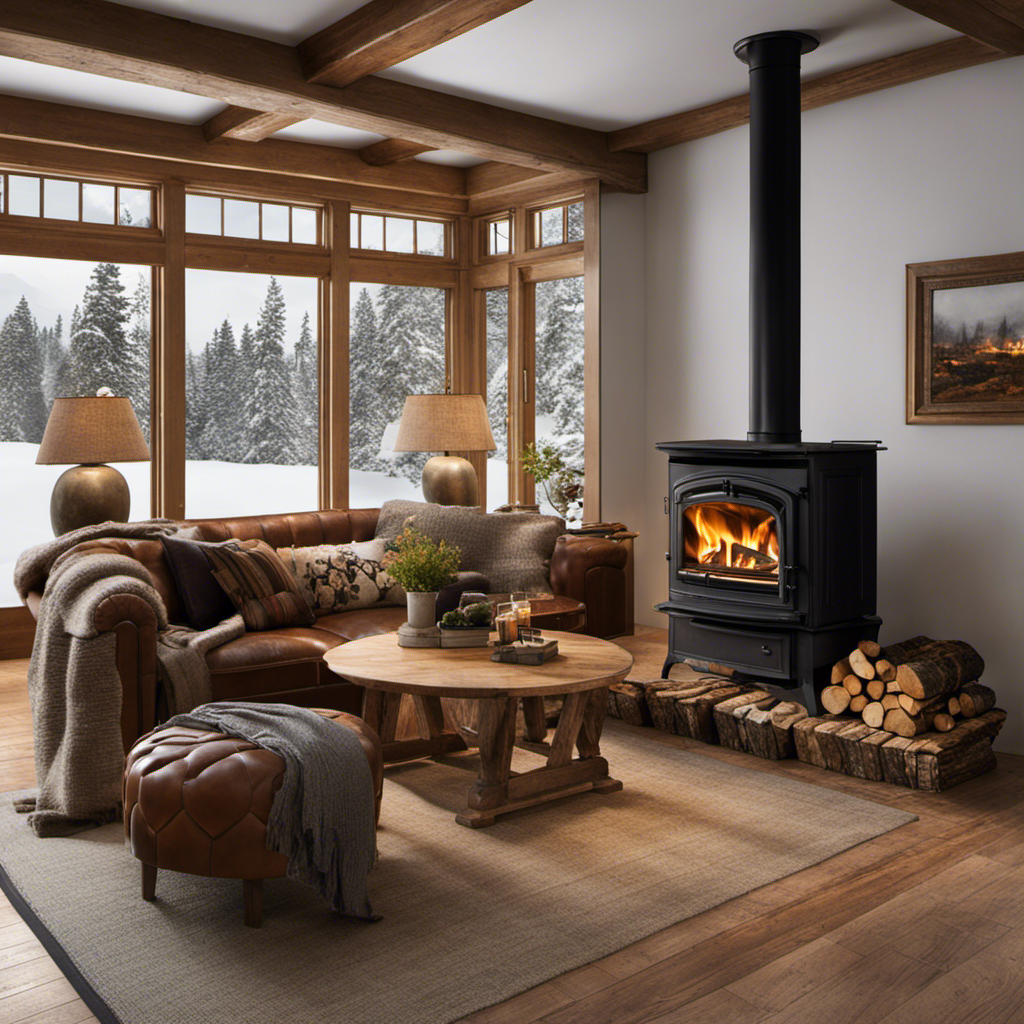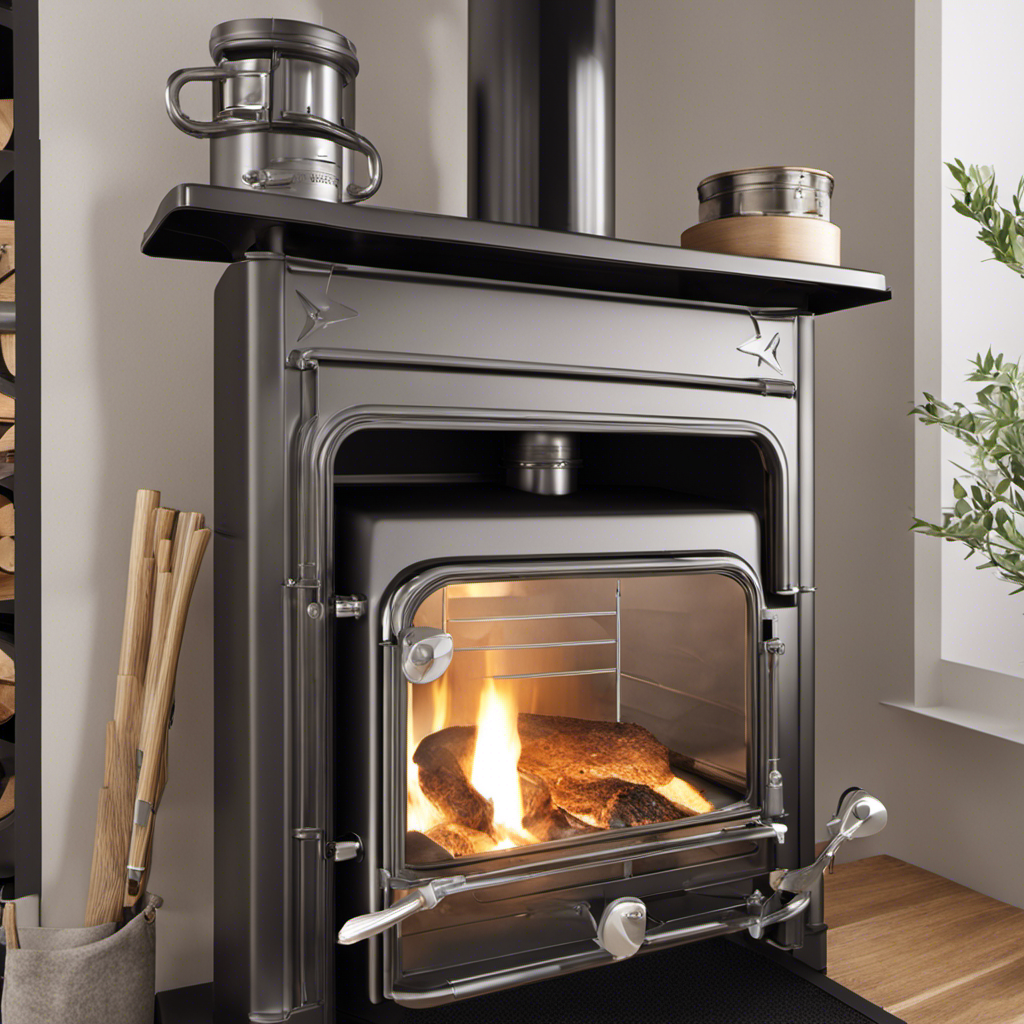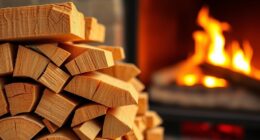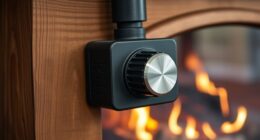As the saying goes, “where there’s smoke, there’s fire.” I have expertise in using a wood stove.
In this article, I’ll guide you through the ins and outs of safely and efficiently using a wood stove.
From gathering and preparing firewood to lighting the fire and controlling the heat, I’ll share my expertise to help you master this traditional heating method.
So let’s dive in and get cozy around the warm embrace of a wood stove.
Key Takeaways
- Proper ventilation is crucial to prevent carbon monoxide poisoning.
- Only burn dry, seasoned wood to avoid excess smoke and carbon monoxide buildup.
- Install smoke and carbon monoxide detectors near the wood stove.
- Regularly inspect and clean the chimney to prevent blockages or soot buildup.
Safety Precautions
I need to make sure I follow all the safety precautions when using a wood stove. One of the most important precautions is to prevent carbon monoxide poisoning. Carbon monoxide is a colorless, odorless gas that can be produced by the incomplete combustion of wood. It’s extremely dangerous and can cause severe health problems or even death. To avoid this, proper ventilation is crucial.
Firstly, it’s essential to ensure that the wood stove is installed in a well-ventilated area. This means having a chimney or flue that allows the smoke and gases to escape safely. A professional should inspect and clean the chimney regularly to prevent any blockages or buildup of soot.
Secondly, it’s important to never burn anything other than dry, seasoned wood in the stove. Burning wet or green wood can create excess smoke and increase the risk of carbon monoxide buildup. Additionally, using accelerants like gasoline or kerosene should be strictly avoided as they can lead to a dangerous fire or explosion.
Lastly, installing carbon monoxide detectors near the wood stove is an excellent safety measure. These detectors will sound an alarm if the gas levels become too high, giving you time to evacuate and seek fresh air.
Gathering and Preparing Firewood
To ensure a successful fire, it’s crucial to gather and prepare a sufficient amount of firewood. Here are some tips on how to do it effectively:
-
Selecting the right wood: Choose hardwoods like oak, maple, or birch. They burn longer and produce more heat compared to softwoods like pine or cedar.
-
Splitting logs: Use a splitting maul or an axe to split the logs into manageable pieces. Start by positioning the log on a chopping block and strike it firmly with the maul, aiming for the center. Repeat until the log splits into smaller pieces.
-
Drying the wood: Seasoned firewood burns more efficiently. Store the split logs in a dry, well-ventilated area for at least six months to a year. This allows the wood to dry out and reduces the amount of smoke produced.
-
Storing firewood: Stack the firewood off the ground to prevent moisture absorption. Create a raised platform or use a firewood rack. Make sure the stack is stable and allows for proper air circulation.
Lighting the Fire
When lighting a fire, it’s important to start with small pieces of kindling to help ignite the larger logs. Proper firewood storage and seasoning are crucial for creating a successful fire.
Firewood should be stored in a dry, well-ventilated area to prevent mold and rot. It’s recommended to stack the firewood off the ground, on a raised platform or pallet, to keep it away from moisture. This helps ensure that the wood remains dry and ready for use.
Firewood seasoning is the process of drying the wood before burning it. Freshly cut wood contains a high moisture content, which makes it difficult to ignite and produces less heat. To season firewood, it should be split into smaller pieces, exposing more surface area to the air. These pieces are then stacked in a single layer, allowing air to circulate around them. It’s important to cover the top of the stack to protect it from rain and snow, while still allowing air to flow.
Properly seasoned firewood should have a moisture content of around 20%, which ensures efficient burning and maximum heat output. When lighting the fire, start with small pieces of kindling, such as twigs or newspaper, placed at the bottom of the firebox. These small pieces ignite quickly and provide the initial flame needed to ignite the larger logs. Gradually add larger pieces of firewood, making sure to leave enough space for air circulation.
With the right kindling and well-seasoned firewood, you’ll have a warm and cozy fire in no time.
Controlling the Heat and Airflow
Controlling the heat and airflow is essential for maintaining a steady and comfortable temperature in the room. As someone who’s used a wood stove for many years, I’ve learned a few key techniques for adjusting the temperature and regulating the oxygen supply. Here are four steps to help you achieve the perfect balance:
-
Adjust the air vents: Most wood stoves have air vents that allow you to control the amount of oxygen entering the firebox. By opening the vents, more oxygen will be supplied, resulting in a hotter fire. Closing the vents will reduce the oxygen supply and lower the temperature. Experiment with different vent positions until you find the desired heat level.
-
Use a damper: Some wood stoves come with a built-in damper that controls the airflow through the chimney. By adjusting the damper, you can regulate the amount of heat escaping from the stove. Opening the damper will increase the airflow and heat transfer, while closing it will retain more heat in the stove.
-
Add or remove wood: The amount of wood in the stove directly affects the temperature. Adding more wood will increase the heat output, while removing wood will reduce it. Pay attention to the size and type of wood you use, as this can also impact the heat produced.
-
Monitor the temperature: Invest in a stove thermometer to accurately monitor the temperature inside the stove. This will help you determine if adjustments need to be made to the air vents, damper, or wood supply.
Cleaning and Maintenance
As an experienced wood stove user, I find that regular cleaning and maintenance are crucial for ensuring optimal performance and longevity.
One of the key aspects of maintaining a wood stove is keeping the chimney clean. Over time, soot and creosote can build up in the chimney, which can obstruct airflow and increase the risk of a chimney fire.
To clean the chimney, I recommend using a chimney brush and extension rods. Start by removing the chimney cap and carefully inserting the brush into the chimney. Move the brush up and down, using a twisting motion to loosen the buildup.
Once the chimney is clean, it’s important to remove the ash from the stove regularly. Excessive ash can restrict airflow and make it harder to control the temperature. When removing ash, make sure the stove is completely cooled down.
Use a metal scoop or shovel to carefully scoop out the ash into a metal container. Avoid using a vacuum cleaner, as hot embers can ignite the dust inside the vacuum.
Frequently Asked Questions
Can I Use Any Type of Wood in a Wood Stove?
Yes, you can use different types of wood in a wood stove.
However, it’s important to choose the right type of firewood suitable for wood stoves.
Hardwoods like oak, maple, and birch are ideal because they burn longer and produce more heat.
Softwoods like pine and spruce can be used, but they burn faster and may create more creosote buildup.
Remember to properly store firewood in a dry, well-ventilated area to ensure it burns efficiently.
How Long Does It Take for a Wood Stove to Heat up a Room?
To properly maintain a wood stove and improve its efficiency, it’s important to understand how long it takes for the stove to heat up a room.
Factors such as the size of the stove, the type of wood used, and the insulation of the room can all affect the heating time.
Generally, it can take anywhere from 30 minutes to a few hours for a wood stove to fully heat up a room, but it’s important to monitor the temperature and adjust the airflow accordingly to ensure efficient heating.
Is It Safe to Leave a Wood Stove Unattended?
Leaving a wood stove unattended can be dangerous and isn’t recommended. It’s important to prioritize safety when dealing with wood stoves.
Regular wood stove maintenance is key to prevent potential hazards such as chimney fires, carbon monoxide leaks, and overheating. Always ensure that the stove is properly installed, use dry and seasoned wood, and regularly clean the chimney and flue.
Never leave a wood stove unattended to minimize the risk of accidents and ensure the safety of your home.
Can I Cook on a Wood Stove?
Cooking on a wood stove isn’t only possible, but it also adds a unique flavor to your dishes. With the right cooking techniques and recipes, you can create delicious meals using the heat from your wood stove.
From soups and stews to roasted meats and baked bread, the possibilities are endless. Just make sure to adjust the temperature and placement of your pots and pans to achieve even cooking.
How Often Should I Have My Wood Stove Professionally Inspected and Cleaned?
How often should I’ve my wood stove professionally inspected and cleaned?
It’s recommended to have your wood stove professionally inspected and cleaned at least once a year to ensure optimal performance and safety. Regular maintenance is crucial to prevent creosote build-up, which can lead to chimney fires. A professional inspection will identify any potential issues or repairs needed.
Additionally, routine cleaning will help maintain efficiency and extend the lifespan of your wood stove.
Conclusion
In conclusion, using a wood stove can be a rewarding and efficient way to heat your home.
By following proper safety precautions, gathering and preparing firewood, lighting the fire correctly, and controlling the heat and airflow, you can ensure a safe and comfortable experience.
Remember, a wood stove is like a warm embrace on a cold winter’s night, providing both warmth and ambiance to your living space.
So embrace the warmth and enjoy the cozy atmosphere that a wood stove can bring to your home.
Logan’s affair with adventure began in childhood. He hailed from a small town where vast forests bordered one side and endless shores stretched on the other. His days were spent exploring uncharted woods, climbing tall trees, or listening to the tales of old sailors. This early immersion in a world brimming with stories and mysteries became the foundation of his passion for writing.











